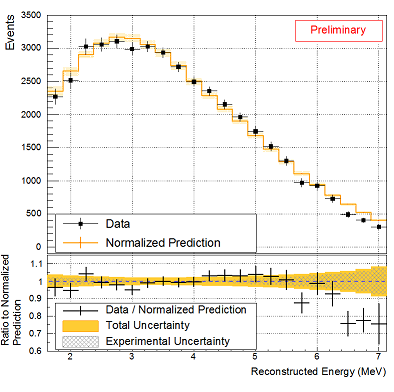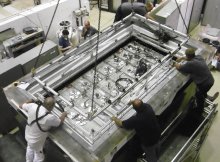STEREO is moving up a gear
The STEREO experiment releases new results based on the detection of about 65000 neutrinos at short distance from the research reactor of the ILL-Grenoble. The improved accuracy is rejecting the hypothesis of a 4th neutrino in a large fraction of the domain predicted from the reactor neutrino anomaly. Profiting from a good control of the detector response, STEREO now also releases its first absolute measurements of the neutrino rate and the spectrum shape.
Omnipresent particles, neutrinos are under scrutiny in all kind of detectors to test the theory of the Standard Model, to witness the inside of reactors or stars, or to study the most violent and large-scale phenomena in the Universe. The detection of the faint signals left by the neutrinos has thus entered a high precision era… revealing new anomalies. The goal of the STEREO experiment is to perform a direct test of the existence of a hypothetical 4th neutrino, which could reconcile the so far unexplained deficit of neutrinos detected close to nuclear reactors (the reactor neutrino anomaly).
The STEREO detector is installed since end of 2016 at 10 m from the core of the reactor of the Institut Laue-Langevin (ILL) in Grenoble, France. It measures precisely the rates and energy spectra of the neutrinos emitted by the core in 6 identical detector cells. If a 4th neutrino exists, it will “oscillate” with the standard neutrinos, inducing a unique pattern of spectral distortions from one cell to another. However, the spectra measured in the 6 cells of the STEREO detector have compatible shapes and need a very careful analysis. The present result significantly shrinks the domain of existence of the 4th neutrino (Figure 1). As STEREO continues taking data it will improve its sensitivity and test the surviving zone, toward even smaller expected amplitudes of oscillations.

Beyond the cell-to-cell comparison, a more difficult task is the control of the absolute response of the detector. The STEREO result is of great interest because the nuclear fuel of the ILL core is highly enriched and the neutrinos originate from the fission of a unique isotope, 235U, instead of a mix of 4 fissioning isotopes at commercial reactors. The spectrum shape as measured by the sum of the 6 cells shows a remarkable agreement with the predicted shape (figure 2) for a pure 235U spectrum up to 6.3 MeV, but deviations beyond the estimated uncertainties are also seen at the highest energies. STEREO has not expressed its full potential yet. Complementary calibration observables are under study to reduce further the shape uncertainties and as many neutrinos as already acquired are expected by until mid-2020!

STEREO is a French-German experiment. The LAPP took on from the beginning the role of designing and constructing part of the shielding of the experiment (lead slabs) as well as the steel structure supporting the 95 tons of STEREO. The group also developed an automatized calibration system using radioactive sources. LAPP’s physicists participate in the data-taking and in the data analysis.
More information :
- Contact at LAPP: Pablo Del Amo Sanchez
- Results shown at the Rencontres de Moriond EW


